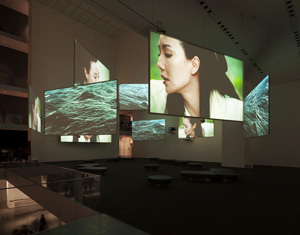8.13.24 — Losing Objectivity
To pick up from last time, the 2024 Whitney Biennial is thinking big. It has not just the museum’s two largest floors, including both terraces, but also the lobby and the space outside the education department and theater.
They, too, have lost their intimacy. Entering the lobby gallery is like entering New York itself, with a shopping cart, a fire hydrant on its side, and other debris, although Ser Serpas herself has left the city for LA. If steel spheres framed by piled fencing look like spaceships, welcome to the known universe. Two floors up, Pippa Garner papers the walls with hundreds of pretend advertisements for her own inventions. 
Any biennial is daunting, much like the art fairs or a month in the galleries. Take dozens of artists with a work apiece and call it art now. Do not even try to keep up with the latest thing, lest one lose one’s objectivity, and the 2015 Biennial had a median age of past fifty. Always bear in mind the rediscovery of painting in the new century. This time, though, the Whitney is all over the map. The curators, Chrissie Iles and Meg Onli with Min Sun Jeon and Beatriz Cifuentes, refuse the whole idea of objectivity.
They speak instead of the “permeability” of relationships, the “fluidity” of identity, and the “precariousness of the natural and constructed worlds.” They evoke AI as better than the real thing. In practice, the sole AI art is in another show entirely, now closed—of Harold Cohen a floor above. The closest thing here looks like characters from a bad superhero movie, in a familiar cross between a robot’s armor and winter parkas. Holly Herndon and Mat Dryhurst claim only to be training the data behind artificial intelligence. It has a lot to learn.
Still, the 2024 Biennial speaks more of certainty than fluidity, and its welcome is precarious at that. Garner’s ads, the Whitney swears, dismantle marketing and gender. That huge video past the clouds, by Tourmaline, celebrates a trans black activist and performance artist. Between the yellow walls, the artist, P. Staff, appears in silhouette in ominous black. An electrically charged orange mesh protects the ceiling. And here you thought you could ascend to the clouds.
Already you know what to expect. Nothing will be clear, and everything will be political, if only you could say why and how. The artist will always be present, especially in absence, as with body casts by Jes Fan or bathroom cabinets from Carolyn Lazard filled with petroleum jelly. New media and performance will dominate, from music to dance video by Ligia Lewis that leaves the dancers as ghosts. Thanks to Holland Andrews, freight elevator and stairwell leading up are awash in sound. Here at last is the biennial’s promised “dissonant chorus.”
Almost anyone and anything can count as American art and add to its vitality. Lewis, who lives in Germany, is from the Dominican Republic, Staff from the UK. Everything verges, too, on art-world platitudes, but with a twist: art here is material and big. That industrial orange curtain has its echo in a descending sheet of smoked glass from Charisse Pearlina Weston. Either might shatter as it falls—and not without a threat to you, and I walk you through the biennial next time to get to know the artists and to see how the permeability and the threats play out.
Read more, now in a feature-length article on this site.